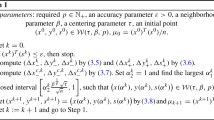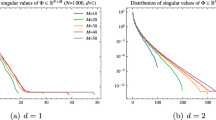Abstract
We study four measures of problem instance behavior that might account for the observed differences in interior-point method (IPM) iterations when these methods are used to solve semidefinite programming (SDP) problem instances: (i) an aggregate geometry measure related to the primal and dual feasible regions (aspect ratios) and norms of the optimal solutions, (ii) the (Renegar-) condition measure C(d) of the data instance, (iii) a measure of the near-absence of strict complementarity of the optimal solution, and (iv) the level of degeneracy of the optimal solution. We compute these measures for the SDPLIB suite problem instances and measure the sample correlation (CORR) between these measures and IPM iteration counts (solved using the software SDPT3) when these measures have finite values. Our conclusions are roughly as follows: the aggregate geometry measure is highly correlated with IPM iterations (CORR = 0.901), and provides a very good explanation of IPM iterations, particularly for problem instances with solutions of small norm and aspect ratio. The condition measure C(d) is also correlated with IPM iterations, but less so than the aggregate geometry measure (CORR = 0.630). The near-absence of strict complementarity is weakly correlated with IPM iterations (CORR = 0.423). The level of degeneracy of the optimal solution is essentially uncorrelated with IPM iterations.
Similar content being viewed by others
References
Alizadeh F., Haeberly J.P.A., Overton M.L. (1997): Complementarity and nondegeneracy in semidefinite programming. Math. Program. 77, 111–128
Alizadeh F., Haeberly J.P.A., Overton M.L. (1998): Primal-dual interior-point methods for semidefinite programming: convergence rates, stability and numerical results. SIAM J. Optim. 8(3): 746–768
Bhatia R. (1997): Matrix Analysis. Springer, Berlin Heidelberg New York
Cai, Z., Freund, R.M.: On two measures of problem complexity and their explanatory value for the performance of SeDuMi on second-order cone problems. Comput Optim Appl (in press)
Chai J., Toh K. (2006): Computation of condition numbers for linear programming problems using Peña’s method. Optim. Methods. Softw. 21, 419–443
Freund, R.M.: On the primal–dual geometry of level sets in linear and conic optimization. SIAM J. Optim. 13(4) (2003)
Freund R.M. (2004): Complexity of convex optimization using geometry-based measures and a reference point. Math. Program. 99, 197–221
Freund R.M., Vera J.R. (1999): Some characterizations and properties of the “distance to ill-posedness" and the condition measure of a conic linear system. Math. Program. 86(2): 225–260
Freund R.M., Vera J.R. (2003): On the complexity of computing estimates of condition measures of a conic linear system. Math. Oper. Rese. 28(4): 625–648
Ji J., Potra F., Sheng R. (1999): On the local convergence of a predictor-corrector method for semidefinite programming. SIAM J. Optim 10(1): 195–210
Kojima M., Shida M., Shindoh S. (1998): Local convergence of predictor–corrector infeasible-interior-point algorithms for sdps and sdlcps. Math. Program. 80(2): 129–160
Lu Z., Monteiro R. (2005): Error bounds and limiting behavior of weighted paths associated with the sdp map X 1/2 SX 1/2. SIAM J. Optim. 15(2): 348–374
Luo Z.Q., Sturm J., Zhang S. (1998): Superlinear convergence of a symmetric primal-dual path following algorithm for semidefinite programming. SIAM J. Optim. 8(1): 59–81
Ordóñez F., Freund R.M. (2003): Computational experience and the explanatory value of condition measures for linear optimization. SIAM J. Optim. 14(2): 307–333
Peña J. (2002): Two properties of condition numbers for convex programs via implicitly defined barrier functions. Math. Program. 93(1): 55–57
Potra F., Sheng R. (1998): Superlinear convergence of interior-point algorithms for semidefinite programming. J. Optim. Theory Appl. 99(1): 103–119
Potra F., Wright S. (2000): Interior-point methods. J. Comput Appl. Math. 124, 281–302
Renegar J. (1994): Some perturbation theory for linear programming. Math. Program. 65(1): 73–91
Renegar J. (1995): Linear programming, complexity theory, and elementary functional analysis. Math. Program. 70(3): 279–351
Robinson S.M. (1977): A characterization of stability in linear programming. Oper. Res. 25(3): 435–447
Toh K.C. (2004): Solving large scale semidefinite programs via an iterative solver on the augmented systems. SIAM J. Optim. 14, 670–698
Tütüncü R.H., Toh K.C., Todd M.J. (2003): Solving semidefinite-quadratic-linear programs using sdpt3. Math. Program. 95(2): 189–217
Wolkowicz, H., Saigal, R., Vandenberghe, L.: Handbook of semidefinite programming. Kluwer (2000)
Author information
Authors and Affiliations
Corresponding author
Additional information
This paper is dedicated in memory of Jos Sturm.
This research has been partially supported through the MIT-Singapore Alliance.
Rights and permissions
About this article
Cite this article
Freund, R.M., Ordóñez, F. & Toh, KC. Behavioral measures and their correlation with IPM iteration counts on semi-definite programming problems. Math. Program. 109, 445–475 (2007). https://doi.org/10.1007/s10107-006-0035-y
Received:
Accepted:
Published:
Issue Date:
DOI: https://doi.org/10.1007/s10107-006-0035-y
Keywords
- Behavioral measure
- Condition number
- Degeneracy
- Complementarity
- Interior-point method
- Semi-definite programming




